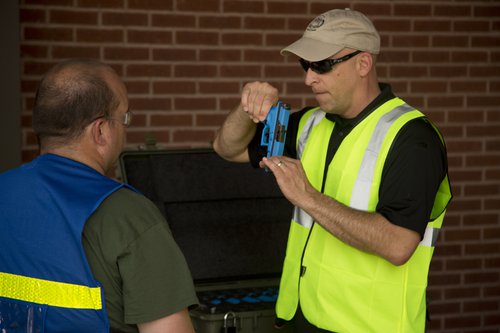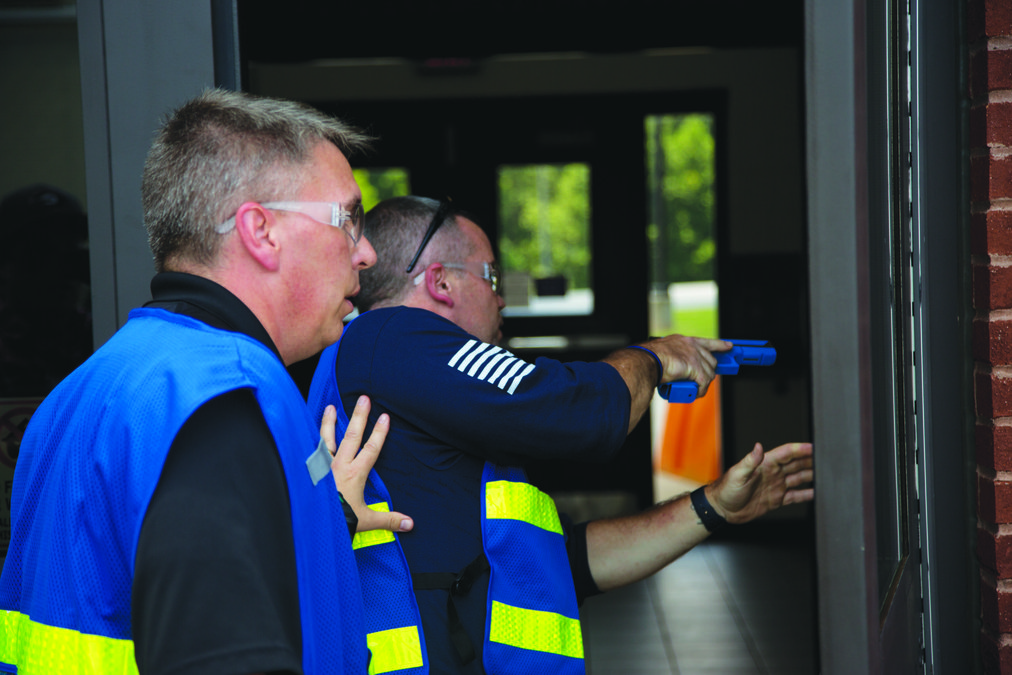A call comes over the radio at 1:15 p.m. and the message is bad news.
"... 911 calls have come in reporting that the gunman has entered a baggage claim area of the airport terminal. The suspect is armed with a handgun, multiple shots have been fired, and casualties have been confirmed," echoes from nearly a dozen radios of deputies and officers waiting in a huddle on a covered back loading dock at North Forsyth High School.
And from the mass, a voice asks, "Airport? Where the heck are we?"
Moments later the radio crackles back to life, issuing orders, and two deputies spring into action. They sprint across a parking lot and draw sidearms before entering the building to face whatever might be inside.

As the two men enter, passing victims laying in the corridor and witnesses that run past with hands held high, a goateed man in a black t-shirt pops out of a classroom brandishing a gun and is shot down. But as they enter the classroom to cuff and search their “suspect,” it becomes clear the gun in his hand is a dummy weapon and the black shirt he wears is emblazoned “Forsyth County Fire Department” across it’s back.
The shooting isn’t real. Just a training exercise, put on for the Forsyth County Sheriff's Office and the Forsyth County Fire Department by ALERRT (Advanced Law Enforcement Rapid Response Training), a group out of San Antonio, Texas dedicated to training law enforcement agencies and emergency responders how to effectively deal with active shooter situations.
"In the event of a mass shooting event or active shooter event, it requires all three disciplines to save lives,” said ALERRT Instructor Troy Smoot. “It starts with police obviously, but it takes cooperation between EMS and Fire working together with police to get people to the hospital as quickly as possible.”
Smoot, a 20-year veteran of the San Antonio Police Department, and his fellow instructors travel across the nation training emergency responders using real scenarios to drive home how tragedies have happened in the past and how officers have responded to them.
This week, ALERRT instructors were at North Forsyth High School, working with local emergency responders on a number of different trainings and scenarios.

"Because of all the different moving parts with law enforcement, Fire, EMS, all of us being different radio channels, different policies and procedures, different command staff … This helps bridge that gap,” said Deputy Nick Sarisky, of the sheriff's office’s training unit. “So that we work better together and we know what to expect from each other.”
In addition to the threat of one or more “shooters” in the scenario, Sarisky said that deputies are faced with tactical challenges of dealing with victims, unharmed witnesses and coordinating in an unknown scene.
"They will have some type of driving force that is going to push them to one area of the school, whether that’s shots fired, people screaming for help, seeing injured people in the hallway,” Sarisky said. “They have got to then deal with that situation with whatever is presented to them at that time."
Deputies also have to fight against initial instincts to help the injured and prioritize the dangers the scene presents to them.
Sarisky said that in the past the sheriff’s office has done other “self-generated” active shooter training at other schools, but this is the first time that they have been put through a course specifically designed to test how they handle an integrated response with law enforcement, EMS and Fire.
"This is definitely also a way to help teach the officers, the paramedics and the firefighters what they need to do in these situations, how they need to handle it, how they need to respond to it,” Sarisky said.
And that idea of an integrated response is evident in the scenario. Deputies cleared the school hallway, covering exits and entrances with weapons drawn. Crews of firefighters and paramedics rushed in and out of the scene, flanked by an armed escort.

"In the past, Fire and EMS may not come to the scene until the scene is completely clear … We are bringing them in to "warm" areas, where it's secure, but we haven’t finished clearing the entire building," Sarisky explained.
"Being able to get victims out faster,” he says with a nod towards the rushing responders. “Because we want to obviously stop the killing first, but stop the dying next."
After the scenario is played out, and all victims and suspects are removed from the scene by emergency responders, the crew regroups in the courtyard for water, sport's drinks and a debriefing.
Smoot said that debriefings are an important part of the training to let the group reflect on how the scenario played out.
“We all kind of learn from what the other person was doing,” Sarisky said. “We rehash the event, how it was handled properly and what we can do better."
Beyond the scenarios themselves, Smoot said that ALERRT was founded on the idea of “debriefing” after active shooter situations, analyzing what happened, how it was handled and what could be done differently in the future.

He said that ALERRT was started in 2002 in the wake of some of the very first active shooter tragedies. They started by training police officers in Texas and spread from there, eventually taking their training on the road.
"Unfortunately, over the years we have learned a lot on what works and what does not work on events like this,” Smoot said. "It's always evolving, we are learning from past events … and we are constantly changing in our response with tactics."
To make things even easier, he said that their training comes at no cost to officers or their department, and is funded wholly by grants.

